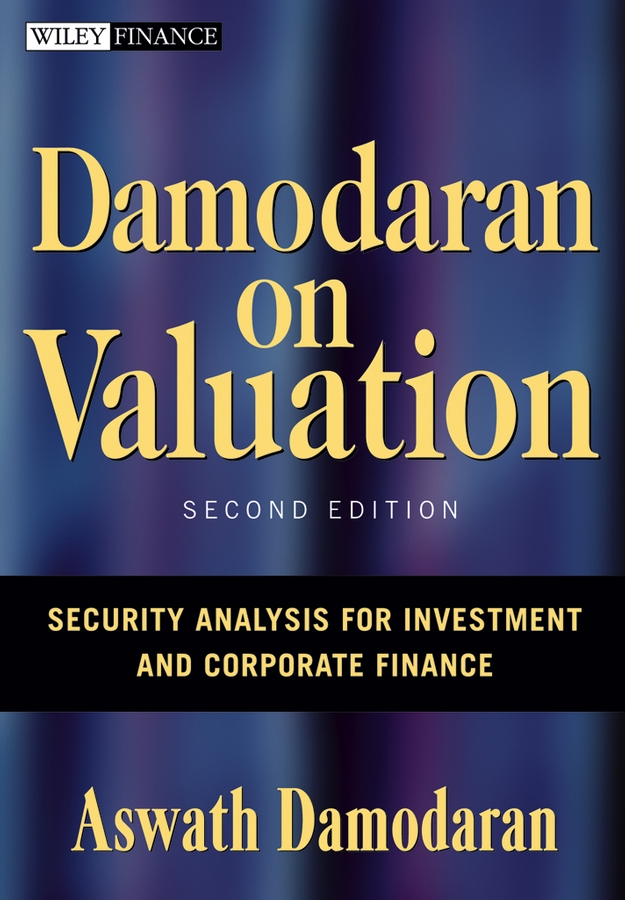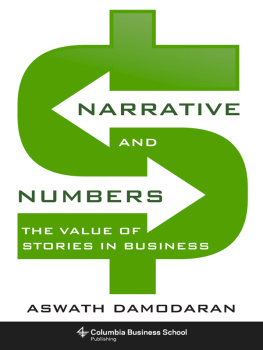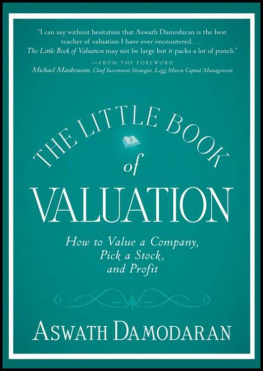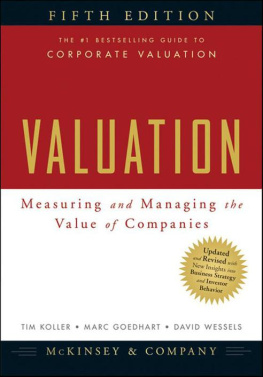Aswath Damodaran - Damodaran on Valuation
Here you can read online Aswath Damodaran - Damodaran on Valuation full text of the book (entire story) in english for free. Download pdf and epub, get meaning, cover and reviews about this ebook. year: 2006, publisher: John Wiley & Sons, Inc., genre: Business. Description of the work, (preface) as well as reviews are available. Best literature library LitArk.com created for fans of good reading and offers a wide selection of genres:
Romance novel
Science fiction
Adventure
Detective
Science
History
Home and family
Prose
Art
Politics
Computer
Non-fiction
Religion
Business
Children
Humor
Choose a favorite category and find really read worthwhile books. Enjoy immersion in the world of imagination, feel the emotions of the characters or learn something new for yourself, make an fascinating discovery.

- Book:Damodaran on Valuation
- Author:
- Publisher:John Wiley & Sons, Inc.
- Genre:
- Year:2006
- Rating:5 / 5
- Favourites:Add to favourites
- Your mark:
- 100
- 1
- 2
- 3
- 4
- 5
Damodaran on Valuation: summary, description and annotation
We offer to read an annotation, description, summary or preface (depends on what the author of the book "Damodaran on Valuation" wrote himself). If you haven't found the necessary information about the book — write in the comments, we will try to find it.
Damodaran on Valuation — read online for free the complete book (whole text) full work
Below is the text of the book, divided by pages. System saving the place of the last page read, allows you to conveniently read the book "Damodaran on Valuation" online for free, without having to search again every time where you left off. Put a bookmark, and you can go to the page where you finished reading at any time.
Font size:
Interval:
Bookmark:

Contents
Founded in 1807, John Wiley & Sons is the oldest independent publishing company in the United States. With offices in North America, Europe, Australia, and Asia, Wiley is globally committed to developing and marketing print and electronic products and services for our customers professional and personal knowledge and understanding.
The Wiley Finance series contains books written specifically for finance and investment professionals as well as sophisticated individual investors and their financial advisors. Book topics range from portfolio management to e-commerce, risk management, financial engineering, valuation, and financial instrument analysis, as well as much more.
For a list of available titles, visit our Web site at www.WileyFinance.com .

Copyright 2006 by Aswath Damodaran. All rights reserved.
Published by John Wiley & Sons, Inc., Hoboken, New Jersey. Published simultaneously in Canada.
No part of this publication may be reproduced, stored in a retrieval system, or transmitted in any form or by any means, electronic, mechanical, photocopying, recording, scanning, or otherwise, except as permitted under Section 107 or 108 of the 1976 United States Copyright Act, without either the prior written permission of the Publisher, or authorization through payment of the appropriate per-copy fee to the Copyright Clearance Center, Inc., 222 Rosewood Drive, Danvers, MA 01923, (978) 750-8400, fax (978) 646-8600, or on the web at www.copyright.com . Requests to the Publisher for permission should be addressed to the Permissions Department, John Wiley & Sons, Inc., 111 River Street, Hoboken, NJ 07030, (201) 748-6011, fax (201) 748-6008, or online at http://www.wiley.com/go/permissions .
Limit of Liability/Disclaimer of Warranty: While the publisher and author have used their best efforts in preparing this book, they make no representations or warranties with respect to the accuracy or completeness of the contents of this book and specifically disclaim any implied warranties of merchantability or fitness for a particular purpose. No warranty may be created or extended by sales representatives or written sales materials. The advice and strategies contained herein may not be suitable for your situation. You should consult with a professional where appropriate. Neither the publisher nor author shall be liable for any loss of profit or any other commercial damages, including but not limited to special, incidental, consequential, or other damages.
For general information on our other products and services or for technical support, please contact our Customer Care Department within the United States at (800) 762-2974, outside the United States at (317) 572-3993 or fax (317) 572-4002.
Wiley also publishes its books in a variety of electronic formats. Some content that appears in print may not be available in electronic books. For more information about Wiley products, visit our web site at www.wiley.com .
Library of Congress Cataloging-in-Publication Data:
Damodaran, Aswath.
Damodaran on valuation : security analysis for investment and corporate finance / Aswath Damodaran.2nd ed.
p. cm.(Wiley finance series) Includes index.
ISBN-13 978-0-471-75121-2 (cloth) ISBN-10 0-471-75121-9 (cloth)
1. CorporationsValuationMathematical models. 2. Capital assets pricing model. 3. Investment analysis. I. Title. II. Series.
HG4028.V3D35 2006 658.15dc22
2006004905
To all those people with whom
I have debated valuation issues over time
and who have pointed out the errors
(or at least the limitations)
of my ways
Preface
There is nothing so dangerous as the pursuit of a rational investment policy in an irrational world.
John Maynard Keynes
Lord Keynes was not alone in believing that the pursuit of true value based on financial fundamentals is a fruitless one in markets where prices often seem to have little to do with value. There have always been investors in financial markets who have argued that market prices are determined by the perceptions (and misperceptions) of buyers and sellers, and not by anything as prosaic as cash flows or earnings. I do not disagree with them that investor perceptions matter, but I do disagree with the notion that they are all that matter. It is a fundamental precept of this book that it is possible to estimate value from financial fundamentals, albeit with error, for most assets, and that the market price cannot deviate from this value in the long term. From the tulip bulb craze in Holland in the early seventeenth century to the South Sea Bubble in England in the 1800s to the stock markets of the present, markets have shown the capacity to correct themselves, often at the expense of those who believed that the day of reckoning would never come.
The first edition of this book was my first attempt at writing a book, and hopefully I have gained from my experiences since. In fact, this edition is very different from the prior edition for a simple reason. My other book on investment valuation, also published by John Wiley & Sons, was designed to be a comprehensive valuation book, and repeating what was said in that book here, in compressed form, strikes me as a waste of time and resources.
This book has three parts to it. The first two parts, which stretch through the first nine chapters, provide a compressed version of both discounted cash flow and relative valuation models and should be familiar territory for anyone who has done or read about valuation before. The third part, which comprises the last nine chapters, is dedicated to looking at what I call the loose ends in valuation that get short shrift in both valuation books and discussions. Included here are topics like liquidity, control, synergy, transparency, and distress, all of which affect valuations significantly but either are dealt with in a piecemeal fashion or take the form of arbitrary premiums and discounts. You will notice that this section has more references to prior work in the area and is denser, partly because there is more debate about what the evidence is and what we should do in valuation. I do not claim to have the answer to what the value of control should be in a firm, but the chapter on control should give you a road map that may help you come up with the answer on your own.
The four basic principles that I laid out in the Preface to the first edition continue to hold on this one. First, I have attempted to be as comprehensive as possible in covering the range of valuation models that are available to an analyst doing a valuation, while presenting the common elements in these models and providing a framework that can be used to pick the right model for any valuation scenario. Second, the models are presented with real-world examples, warts and all, so as to capture some of the problems inherent in applying these models. There is the obvious danger that some of these valuations will appear to be hopelessly wrong in hindsight, but this cost is well worth the benefits. Third, in keeping with my belief that valuation models are universal and not market-specific, illustrations from markets outside the United States are interspersed through the book. Finally, I have tried to make the book as modular as possible, enabling a reader to pick and choose sections of the book to read, without a significant loss of continuity.
Aswath Damodaran
New York, New York
June 2006
But then again, as Keynes would have said, In the long term, we are all dead.
Font size:
Interval:
Bookmark:
Similar books «Damodaran on Valuation»
Look at similar books to Damodaran on Valuation. We have selected literature similar in name and meaning in the hope of providing readers with more options to find new, interesting, not yet read works.
Discussion, reviews of the book Damodaran on Valuation and just readers' own opinions. Leave your comments, write what you think about the work, its meaning or the main characters. Specify what exactly you liked and what you didn't like, and why you think so.






